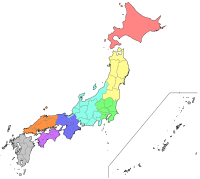
Back مناطق اليابان Arabic Рэгіёны Японіі Byelorussian Региони на Япония Bulgarian জাপানের অঞ্চলের তালিকা Bengali/Bangla Rannvroioù Japan Breton Regions del Japó Catalan Regiony v Japonsku Czech Japans regioner Danish Regionen Japans German Japanaj regionoj Esperanto

| Administrative divisions of Japan |
|---|
| Prefectural |
| Prefectures |
| Sub-prefectural |
| Municipal |
| Sub-municipal |
Japan is often divided into regions, each containing one or more of the country's 47 prefectures at large. Sometimes, they are referred to as "blocs" (ブロック, burokku), or "regional blocs" (地域ブロック, chiiki burokku) as opposed to more granular regional divisions. They are not official administrative units, though they have been used by government officials for statistical and other purposes since 1905. They are widely used in, for example, maps, geography textbooks, and weather reports, and many businesses and institutions use their home regions in their names as well, for example Kyushu National Museum, Kinki Nippon Railway, Chūgoku Bank, and Tōhoku University.
One common division, preferred by the English Wikipedia, groups the prefectures into eight regions. In that division, of the four main islands of Japan, Hokkaidō, Shikoku, and Kyūshū make up one region each, the latter also containing the Satsunan Islands, while the largest island Honshū is divided into five regions. Okinawa Prefecture is usually included in Kyūshū, but is sometimes treated as its own ninth region.[1][2][3]
Japan has eight High Courts, but their jurisdictions do not correspond to the eight Wikipedia regions (see #Other regional divisions and Judicial system of Japan for details).
- ^ "Regions". Archived from the original on 2020-07-27. Retrieved 2021-02-14.
- ^ Regions of Japan
- ^ A Guide to the Regions of Japan